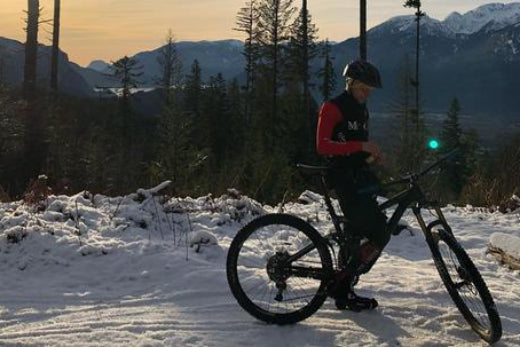By Nick Kleban, elite cyclist // Team Skyline & President of Mcgill cycling
Come wintertime, I love to get outdoors on my fatbike in Montreal! Given Quebec winters can get down to -30 degrees celsius (I don’t ride on the fatbike if it's colder than minus 10 out. I’m not as tough as some people) the cold weather can present challenges for proper nutrition on longer training rides. Most notably, it can be difficult to effectively eat/drink when it’s cold and you are all layered up. Here are some of my tips for outdoor winter training I’ve found are helpful over the years!
Nutritional needs in colder weather
The British Journal of Sports Medicine recommends cyclists should consume 0.7g of carbohydrates per kg of body weight per hour of exercise in temperate conditions. However, they also emphasize that in colder conditions, athletes should be consuming 10-20% more carbs every hour. This is to account for a slightly spiked metabolism as our body reacts to keeping us warm in the cold. Conversely, our hydration requirement is decreased in colder conditions as typically less water is lost through sweat. So basically when it’s freezing out, although you may not need to be slamming two water bottles back an hour, it’s still important to remember to eat, not only for energy but also to stay warm.
Cold Weather Nutrition Tips
I try to pay particular attention to what I eat and drink before leaving because I know when it’s cold, I tend to not eat as much whether due to cold hands that are unable to open packages, lack of thirst or inaccessible food. An hour before, I’ll have a carb-heavy snack (go to is a pb/j - toasted) with a glass of sports drink. This makes sure my carbohydrate reserves are topped up before even leaving the door.
I find personally that sports gels, chews and other soft foods (like the XACT ENERGY fruit bar) are great once out the door for their convenience. Foods like your typical granola bar on the other hand, I find aren’t ideal, as they tend to turn hard as rock in the cold. So basically, the colder it is, the softer food I opt for. Around this time of year, holiday baked goods are a must!
The main problem I run into with winter riding is having my food accessible. Normally, my snacks are buried under a couple jackets or stuffed in a small backpack. On a normal summer training ride, I try to eat on-the-go every hour, but the combination of thick gloves and layers makes this tough when it’s cold.
For me, this usually means finding a nice place on the trails (normally out of the wind/rain) that I can stop and take the time for a quick snack. Usually the pit stop is quick (under 5 minutes) to make sure I don’t get cold while standing around. I tend to do one stop every hour to hour and-a-half when I’m out on a training ride. Sometimes, if it’s really cold or wet out, I don’t stray too far from home so I can make this pitstop indoors and maybe even get something warm to drink before heading back out.
At the end of the day, all this said may not be the most groundbreaking advice, but I’ve found it’s been super helpful in getting me outdoors no matter the weather!
Source
Hassapidou, M. (2011, February 01). Carbohydrate requirements of elite athletes. Retrieved December 29, 2020, from https://bjsm.bmj.com/content/45/2/e2.17
